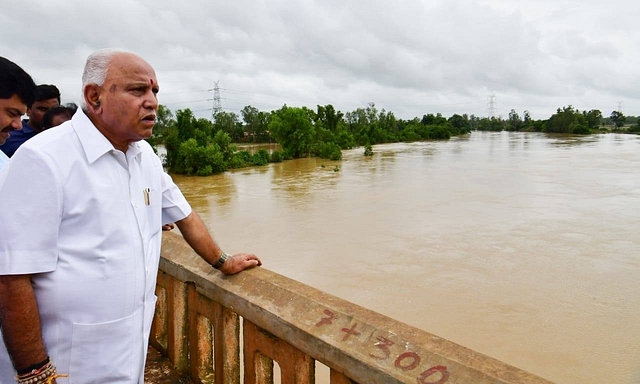
One Man Government? How B S Yediyurappa Is Managing Flood Relief For An Entire State
With Karnataka still recovering from the floods, the opposition parties have wasted no time calling the current dispensation a ‘one-man army’. The jibe is meant to mock BJP’s reluctance to get a cabinet in place for the Karnataka government.
But the septuagenarian B S Yediyurappa and the government machinery appear to have handled the flood situation well and are largely in control of the situation, despite being a ‘one-man government’.
Yediyurappa left his meetings in New Delhi midway and rushed to Karnataka early this month to handle the flood situation in the state.
He has since formed teams involving the MLA’s and MPs of the flood-hit region and ensuring that relief activities are on in full swing.
Over 80 taluks in 17 districts have been announced as being ‘affected by the floods’. An activist who has been part of the relief operations at Belagavi dismissed allegations of any delay in the relief operations owing to a missing cabinet.
Daily reports of the flood situation that are being submitted are being monitored by the Revenue Secretary. The Chief Secretary, T M Vijay Baskar, along with Relief Commissioner, T K Anil Kumar, have been constantly reviewing and monitoring the flood relief operations.
Even as the CM began his recce of the flood affected regions, starting with Belagavi on August 7, four NDRF teams and four army columns were immediately deployed to rescue people from flood-affected areas.
But with relentless rains only making the situations worse, the number of affected districts began to rise, with coastal Karnataka and Kodagu too witnessing a repeat of last year’s flooding.
Nine additional NDRF teams were swung into action on 9 August, five of which headed to Belagavi, two to Kodagu and one each to Uttara Kannada and Shivamogga.
As of 11 August, 66 villages in Kodagu were severely affected, and around 1,700 people had been rescued and evacuated. Around 6,600 people have been housed in 42 relief centres across Kodagu.
B S Yediyurappa, who began his recce on 7 August starting from Belagavi, has toured Chikkodi, Sutagatti villages affected by the Markandeya and Ghataprabha rivers, relief centres at Yaduru and Bagalkote on 8 August, areas around Hubbali including Kudalasangama and Naragunda on 9 August, and has been conducting aerial surveys of the region.
On 11 August, Yediyurappa, joined by union Home Minister, Amit Shah, conducted an aerial survey of the flood-affected regions.
Yesterday he visited the coastal areas of Belthangady and Dakshina Kannada and announced that all those whose houses had been damaged would receive Rs 1 lakh each to repair their houses.
Touring his constituency of Shikaripura in Shivamogga, Yediyurappa offered bagina (ceremonial offerings) to the Tunga river today and has raised a request to the centre to provide Rs 3,000 crore as flood relief, even as the preliminary estimates pin the damage at Rs 10,000 crore.
As of today, the flood situation is said to be normalising although rainfall on the coast is unlikely to reduce for the next five days.
A total of 20 NDRF teams are in various locations across the flood-hit regions, four helicopters of the Indian Army are deployed in Belagavi and Bellari, and one team of the Garuda force is in action in Kodagu.
Apart from these, all nodal officers have been asked to stay in their villages until the vulnerability reduces. While the number of people rescued currently stands at 6,77,382, and those in relief centres is 3,94,486, the reported loss of lives is 48.
It will definitely take one more week for the waters to completely recede and any sense of normalcy begins to prevail in the affected regions. It is only then that the state government’s real test will begin. So far they appear to have managed things well.